I will no longer be blogging at flippingmath.wordpress.com but after 3 years will be starting a new blog at tech4ward.wordpress.com.
All the best.
G
I will no longer be blogging at flippingmath.wordpress.com but after 3 years will be starting a new blog at tech4ward.wordpress.com.
All the best.
G
 Over the last couple of years I have been fortunate enough to connect with a large number of educators either at conferences or online. As people learn more and more about the Flipped Classroom they often have questions. I have found myself answering many of them more these questions on more than one occasion so I thought a blog post was warranted.
Over the last couple of years I have been fortunate enough to connect with a large number of educators either at conferences or online. As people learn more and more about the Flipped Classroom they often have questions. I have found myself answering many of them more these questions on more than one occasion so I thought a blog post was warranted.
Here are my top 5 Flipped Classroom FAQs:
What do you do when students don’t watch the video?
Will firstly I should note that I don’t usually assign videos, or anything for that matter, for homework. Most of my students find they have enough time in class to watch the video that they don’t need to watch it at home. On the days I do assign a video for homework I do so knowing that some for whatever reason will not get to it. I don’t punish the students, I have found more and more that the ‘whack-a-mole’ approach to education is ineffective. Students need to see value in the video and ultimately take responsibility for their learning. Students value the videos because they make the in-class activities more productive and beneficial for them and they don’t want to fall behind. When they haven’t watched the video they often find it difficult to fully engage in the activity and need to rely on their fellow students to offer guidance as they work together.
So if you aren’t lecturing in class what does a day actually looked like?
Here is a video I made explaining it.
How do you make your videos?
There are many different ways but my way is definitely not the only or best way, it just works for me! I use a Lenovo Convertible X220 Tablet PC that enables me to annotate documents on my computer screen. The software I use is a program called Windows Journals that allows me to write over top of my fill-in-the-blank Microsoft Word files. To record the screencasts I use Camtasia Studio which I have found to be the best Screencasting Software out there. It records everything on my screen, gives me plenty of options to edit and then offers a simple way to produce your video to YouTube or wherever else you need to go. I started off using a typical microphone headset but now I use the Samson GoMic. It has great sound and doesn’t look as wild when I choose to use the webcam feature.
How do I get started?
Start small, it’s the biggest tip I could offer. I have seen many educators (myself included) who have tried to record video after video without trying them out with their students. Bring your students into the mix, ask them what they like and what you could improve on. Start with a lesson, then perhaps try an entire unit and if still things are going well try a course. You don’t need to have all the hardware/software I mentioned above either. Download a free 30 day trial from TechSmith and play around with Camtasia and see how it can benefit your students.
Why do you flip?
I flip to make the most of my face-to-face time. I felt that I just wasn’t meeting the needs of my students when I spent the majority of class lecturing. I wasn’t able to differentiate my instruction so I found myself lecturing to the middle. I flipped because I wanted to do more ‘stuff’ in class with that face-to-face time. ‘Stuff’ will be different for each educator but more me I added the following:
 It is a form of abuse to put a test in front of a student when both the student and teacher know the test is going to result in failure. What is the point? Where does that get us? Does it move the learning forward?
It is a form of abuse to put a test in front of a student when both the student and teacher know the test is going to result in failure. What is the point? Where does that get us? Does it move the learning forward?
Yet as I do not condone the above, I am most certainly guilty of it. In the past I had students come to class that were not prepared to be assessed. They often had poor excuses to be honest: they skipped class, they did not do their homework, or simply forgot today was test day. So as the compassionate young man I am, what did I do? I shrugged my shoulders and wished them luck while in the back of my mind I was really thinking how dare you not take my course seriously.
The part that comes next is something that I will always regret and is the reason I am passionate about trying to improve my assessment practices. The unprepared student would grab the test, put his or her name at the top, slowly look around at the rest of the class feverishly solving problems and then slump in their chair. On a few occasions tears would even begin to fall. What did I do? Nothing…. The student would sit in front of that blank test for an hour, although I am sure it felt like an eternity, while I would watch.
I don’t care who you are, that was messed up. No kid should have to feel that regardless of the situation they may have gotten themselves in.
Now I have a simple conversation with each of my students to avoid this.
Before a student attempts a summative assessment we have a quick conversation known as a ‘hot seat.’ On the hot seat students get a chance to demonstrate one-on-one that they are ready. Sometimes I will grill them with some questions, I may ask them to tell me what they found easy/difficult in a unit, or they may summarize the big ideas. But the important part is how I usually begin. “So, how are things?” “Are you ready to go today?” “What can I do to make sure you are successful?” And 95% of them are good to go, but some are not. On the rare occasion a student will tell me he or she simply dropped the ball during a unit. They may have not used their classroom time wisely, forgot to study, or maybe just found the content difficult and need some extra TLC. If that is the case then together we devise a plan of attack for how the student will prepare for their assessment and when they will be assessed.
The shock I see in their faces when I tell them that they aren’t going to take their assessment that day is unbelievable, they almost fall off of their chairs. The best part is 9 out of 10 times students use the additional prepare time to get back in gear and do well on their assessment.
Now I know some may argue that there are deadlines in the ‘real world,’ and I agree there most certainly are. But if the compromise is that a student recognizes his or her mistakes, comes up with a plan to meet the learning outcomes, and then executes that plan than I am a happy teacher. My goal is to help students learn, watching them fail just wasn’t helping.
 A couple months ago 60 Minutes did a piece on NY Times best-selling author Malcolm Gladwell. In the segment Gladwell recited a quote had heard from his mother as a child, “It is important to be bored, it gives your mind a rest.”
A couple months ago 60 Minutes did a piece on NY Times best-selling author Malcolm Gladwell. In the segment Gladwell recited a quote had heard from his mother as a child, “It is important to be bored, it gives your mind a rest.”
This quote resonated with me and got me thinking…Do we let our children rest their minds? Do we allow boredom?
I find myself as a 29 year old new parent as being stuck between two parenting paradigms. When I was a child I remember going out to play, real play, the type of play where my mother knew where I was (approximately) but didn’t know what I was necessarily up to. I remember building snowforts, inventing variations of hide and go seek or tag and playing home run derby in my best friend’s backyard. I also remember being bored and then doing something about it, my mother didn’t solve my boredom for me. 20 year later and I don’t see that type of play happening in our community as much anymore…
We now seem to live in an over-scheduled contrived play date world. Some of my students for instance have piano, dance, and a basketball after school…and I don’t mean throughout the week, that is just one night! Heck, when I was in University I remember tutoring a grade 2 student in math until 10 at night! Yikes!!! Parenting it seems has turned into a never ending chauffeur service of going from one event to another to ensure our children are well-rounded and perpetually stimulated.
My concern is that we are not letting our children be bored. Boredom is seen as the enemy.
I see a connection between boredom and great things happening because of that boredom. When we give our mind a rest we are giving it an opportunity to power up and get ready for brilliance. This is the reason why I encourage students to take mental brain beaks in my classroom. By letting our children create their own play rather than bouncing them from one organized activity to another we give them the power to be bored and then the power to solve their boredom themselves.
So…maybe boredom isn’t so bad sometime. My guess is that if we let them be bored then we’ll get a chance to watch them be brilliant.
 One of the ironic things about Genius Hour is that it is all about giving students freedom over what and how they want to learn. They love this at first, at least they think they do, and then panic sets in. “I can do anything?” “So what do you really want this to look like?” Students have never really done this before. Quite often we have extensive criteria, rubrics, and even exemplars that they can physically look at. The students that tend to ‘win’ at school are really good at mimicking what we are looking for. Take away constraints and they feel like a fish out of water. I want to break this, but looking back at my first semester trying Genius Hour perhaps going all in wasn’t the way…
One of the ironic things about Genius Hour is that it is all about giving students freedom over what and how they want to learn. They love this at first, at least they think they do, and then panic sets in. “I can do anything?” “So what do you really want this to look like?” Students have never really done this before. Quite often we have extensive criteria, rubrics, and even exemplars that they can physically look at. The students that tend to ‘win’ at school are really good at mimicking what we are looking for. Take away constraints and they feel like a fish out of water. I want to break this, but looking back at my first semester trying Genius Hour perhaps going all in wasn’t the way…
My implementation of Genius Hour had a focus on freedom. Students rarely get a chance to work on something they love or are truly interested in so I did not want to bastardize a good thing by putting a lot of constraints in place like we as teachers often do. What do I mean by this? There were no grades, pass or fail was it. Criteria, yes, well kind of, it was co-created with the class and largely left wide open.
Last week I gave students a survey at the end of our semester and the most common response was that students wished there was more structure, I cringed inside hearing this but I was also expecting it! This got me thinking and asking questions, specifically how could Genius Hour be scaffolded? Enter @kuhner15!
Brad had a fantastic idea, why not use some of Dan Meyer Three-Acts Math Tasks as a way of building up to a full scale Genius Hour project. Students can get used to thinking outside the box, working on problems that do not have a definitive start or end point all while still working in the comfortable confines of just answering a math problem. I really liked this! Dan has put together a great list of problems where students could pick out a question that interests them or begin asking their own essential questions. Just working on asking good questions would be a giant step forward in relation to a full Genius Hour project.
So, next semester I am thinking of doing a Dan Meyerish Genius Hour project first to get us heading in the right direction. What are some other ways that you have scaffold the Genius Hour experience for you students?
 A short seven months ago I was fortunate enough to become a father to an absolutely amazing baby girl. When people told me you never know love until you have a child they certainty were right!
A short seven months ago I was fortunate enough to become a father to an absolutely amazing baby girl. When people told me you never know love until you have a child they certainty were right!
Watching our daughter grow and learn through the lens of a teacher has been an extremely valuable experience. Sometimes as a teacher it is tough to truly determine how much your students are learning. Are they just going through the motions with memorization and regurgitation, or is real learning taking place? As parents know, with a baby you can literally see them learn from one minute to the next. I have witnessed her stare at her hand in amazement and slowly move her fingers trying to gauge what they do, I have seen her learn to clap her hands by mimicking us, and most recently the progression from being up on her knees to rocking to crawling has taken place.
As I reflect on the past year I am realizing how much I have learned about how humans grow and develop at any age. Many of the assumptions I had about learning have been affirmed since entering fatherhood and I have also saw some things I didn’t expect to.
Happy New Year everyone, all the best in 2014!
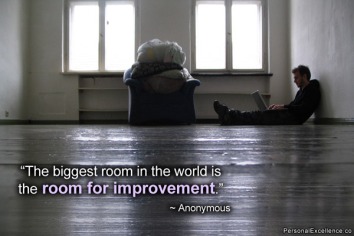 Last month I led my class through our first attempt at Genius Hour and like anything new, there were some ups and some downs. Fortunately the ups far outweighed the downs, but the downs taught me more about my students than I expected to learn. Let’s take a look at the list…
Last month I led my class through our first attempt at Genius Hour and like anything new, there were some ups and some downs. Fortunately the ups far outweighed the downs, but the downs taught me more about my students than I expected to learn. Let’s take a look at the list…
The Ups:
The downs:
So those are my thoughts. My students should be commended for their effort and their willingness to be challenged and grow, but there is room for improvement. This next time around (Thursday) we’ll begin our second project. Students will be given roughly three weeks and 2 full classes to prepare their projects. We’ll spend significant time coming up with good questions using a Pro D activity I often use with adults at conferences called ‘What Sucks?’ This time we’ll do things a little differently…students will simply think about things that suck! As an example: The bus schedule in the area my students go to school is infrequent. How can this be changed given the number of passengers and city budget? We don’t have a cafeteria at our school…How can this be remedied? Who knows, maybe my math class will be on the list of what sucks!?!? Perhaps students can come up with a hack to make it better! In addition, each day over the next couple of weeks I want to model what good (and bad) presentations look like to help use hone in on that skill. Those are the two skills I want to improve the most in my students this time around, coming up with good questions and improving those presentations.
Stay tuned!
The date has been set, October 1st my students will get a chance to get their genius on. I have spent the month scouring through materials and talking to colleagues about how to best make this work and I think I have come up with a plan that I am excited about and comfortable with too.
Here is what our first day will look like:

I am planning to begin with the Marshmallow Challenge. A big thanks to my partner in crime Carolyn (@cdurley) for passing this my way because I think it hits the nail on the head as being a great initial activity. In this activity students are given the task of building the highest structure they can with some basic materials to support a marshmallow. What excites me about this task is that it will help activate the ‘maker’ in students, reveal assumptions that marshmallows aren’t as lite as students thought, and help students understand that assumptions can sometimes be the number one factor inhibiting success. BTW, I create the sweetest playlist ever to play during the competition, pretty excited about that!!!
After this activity I have a series of videos I plan to show to help inspire (keep in mind at this point students still have no idea where this is going. I have kept them in the dark only telling them that we are about to begin something amazing this week):

It was important for me to end off with a video that had a local element. I want students to know that they too can create change, can be inventive, and can inspire. Lastly, I plan to talk to students about how I have been working hard to be a change agent over the last two plus years in the Flipped Classroom world. I also plan to show them a recent video I created which includes interactivity so students can see that I am taking risks myself and continuing to learn and play.
Finally, I will introduce GeniusHour to my students. Perhaps I should call it Geniusweek because that is how I have decided to run it:
I choose to structure first geniushour attempt a little differently than most do. I want to do a number of these projects this semester, rather than just one big one. I have heard of teachers struggling to keep their students eye on the prize when the final project due date is so far away. This way there is a definitive endpoint. So, there it is, a rough outline of my game plan. I am planning to video most of it so stay tuned for a mash-up of all of our learning shenanigans and a blog post where I will look at what worked and what I will change for next time.
I don’t even really like coffee that much but I like going to Starbucks (or any other coffee shop really…). I have never really dissected the experience until now as to why it works for me and the many millions out there but I suppose it must be the atmosphere… You get to drink fatty/sugary goodness and chase it down with equally healthy bakery treats, the service is often good (sometimes they’ll even remember your name if you frequent it enough…Hmmm, not sure I am proud of that), there are comfy chairs and couches, dim lighting to make me look better, hipster music, and even free wifi. What more could you ask for!?!?
My guess is that I am leaving out a number of different aspects that go into the physical makeup of such an establishment, but these are the things I notice. Regardless of why coffee shops like Starbucks work, they have become a meeting place in our society. When I want to catch up with an old friend, work on a project with a colleague, or find a calm place to study a coffee shops seems to like the go to place. You feel comfy, safe, nobody is rushing you along…life is good. So this got me thinking, why can’t my room be more like a Starbucks? I mean nothing screams come on in and enjoy yourself like 30 sterile looking desks and chairs in precise rows, florescent lighting, and faded motivational posters from the 80’s (you know the ones!!!). So with that in mind, I tried to move my classroom as far away from what I used to know, while still staying within my means, to something what was perhaps a little more inviting…
I wrote about this concept in one of my first posts ever and now a couple years later some of those thoughts have come to fruition, here is my work in progress classroom:
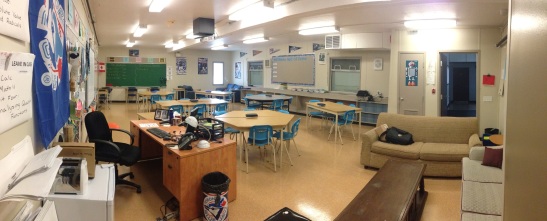
My Classroom, my home away from home…lots of room to move around, a number of different areas to suit different students needs, tables instead of desks for easy collaboration, and above all…hopefully a great place to learn!

Couch seating area with dice stools that can be moved around. Couches are first come first serve, student enjoy the comfort and working with their colleagues.
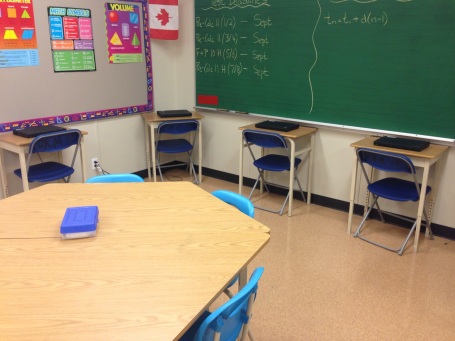
There are 5 single thinkstations for students who want to work alone, watch a video in private, take a quiz/test, or anything else…
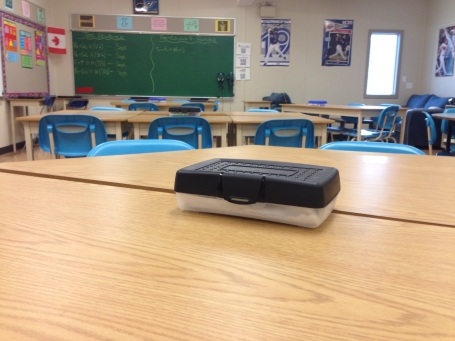
Pencil cases filled with whiteboard pens and erasers for use with our large portable classroom whiteboards (2 ft x 3 ft) and our individual graphing boards. Whiteboarding is definitely by new love when it comes to classroom math activities.

The 2nd Couch area…you may notice I like baseball, especially the Blue Jays. I have baseball posters, math posters, and lots of other shenanigans on the walls!
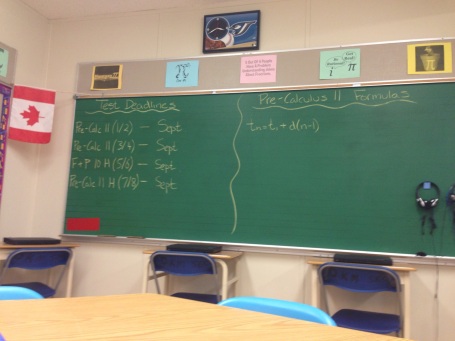
A single old school chalkboard!!! I don’t do a homework wall since my class is self-paced, so instead I list when the test deadlines will be, and as we derive formulas I allow my students to have them on the board.
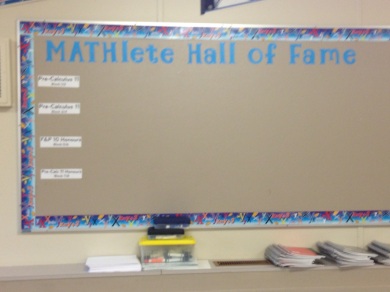
The ‘MATHlete Hall of Fame’ – A tradition of mine…check out this link for more info: https://flippingmath.wordpress.com/2012/12/01/the-mathlete-hall-of-fame/
 Every once in a while I get so excited about learning something new I can’t stop. It is the equivalent of a book you just can’t put down or those rainy days when you watch an entire season of your favorite show. This is an element that I can’t say necessarily exists in my classroom, or the majority of high school classrooms I have seen. But what if it did? What if students were so grossly engaged they didn’t know they were learning and didn’t even want to stop? What if innovation and creativity found their way into high school classrooms?
Every once in a while I get so excited about learning something new I can’t stop. It is the equivalent of a book you just can’t put down or those rainy days when you watch an entire season of your favorite show. This is an element that I can’t say necessarily exists in my classroom, or the majority of high school classrooms I have seen. But what if it did? What if students were so grossly engaged they didn’t know they were learning and didn’t even want to stop? What if innovation and creativity found their way into high school classrooms?
Enter Genius Hour (aka: 20% Time, Passion Projects, etc.). Genius Hour gets its roots from Google. Google employees use 20% of their time to focus on projects they are passionate about so long as the project has the ability to move the company forward, and it has! So why not bring this to education? Over the last couple of years a select few have. In genius hour students create projects they are passionate about but may not necessarily relate to the course curriculum (often because the projects are far ahead of it!). Genius Hour lends itself nicely to Elementary Classrooms because of the cross-curricular nature of this setting. Students can make projects that dabble in science, technology, and English all at once, what a beautiful thing. This got me wondering what it would look like in a High School math classroom.
Last year I experimented with a couple of these projects and they were hugely successful. So much of what we do in education is cookie cutter and I wanted this project to be far from this. As a result freedom was one of my main objectives. I didn’t want students to make me a project, I wanted them to create something for themselves; something they were proud of, passionate about, a project that pushed their learning. I wanted students to quit playing school and focus on something other than harvesting points. I students to take risks and do something extraordinary. As you might imagine this was like a completely different language to them. So I decided to make project pass/fail. If students did the project to a high enough quality (we established a B) they would pass. If they didn’t they would not pass and would be required to redo it. This really seemed to blow them away because it was so foreign to them. Just like it was foreign to me when I took a pass/fail class in my Bachelor of Education degree program. I thought I would only do mediocre work since there was no incentive to work hard, in fact I think I worked harder and I took more risks. My students did the same…. I had a pair make a computer program that after multiple iterations designed a dragon fractal, another pair looked at the math of card-counting, a young lady looked at how we are mathematically running out of music, and another group proved that babies have number sense by a cool experiment they performed on their dog!
The feedback I heard from my students was through the roof and I couldn’t have agreed more. Many said it was their favorite math class ever, right from the research, creation, and presentation of the projects. But unfortunately I felt I only had time to do it once a semester. This year I plan to do things differently, so much so, that this is will be my main focus going into my third year of flipping my classroom.
I have taken a look at the learning outcomes and have identified areas that I can be more efficient and cut out the fat. So my goal is approximately once every two weeks we will spend an hour or two researching and creating projects to present a couple weeks after.
Over the next week I am planning to hammer out the specifics of what the projects will look like during our districts summer Pro-D days, this will make up part II of this blog post. During that time I’ll try to walk the fine line of giving students guidance on what Genius Hour projects can be while not stifling their creativity by giving them too much structure.